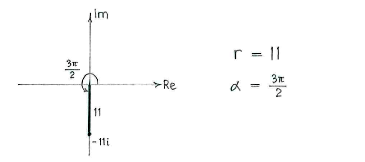Solution 3.2:6b
From Förberedande kurs i matematik 2
(Difference between revisions)
(Ny sida: {{NAVCONTENT_START}} <center> Bild:3_2_6b.gif </center> {{NAVCONTENT_STOP}}) |
m |
||
| (4 intermediate revisions not shown.) | |||
| Line 1: | Line 1: | ||
| - | {{ | + | If we determine the number's magnitude <math>r</math> and argument <math>\alpha </math>, we can write its polar form using the formula |
| - | < | + | |
| - | {{ | + | {{Displayed math||<math>r(\cos\alpha + i\sin\alpha)\,\textrm{.}</math>}} |
| + | |||
| + | Because the number lies on the imaginary axis, it is possible to write its magnitude and argument directly. | ||
| + | |||
| + | [[Image:3_2_6_b.gif|center]] | ||
| + | |||
| + | The polar form is | ||
| + | |||
| + | {{Displayed math||<math>11\Bigl(\cos\frac{3\pi}{2} + i\sin\frac{3\pi}{2}\Bigr)\,\textrm{.}</math>}} | ||
Current revision
If we determine the number's magnitude \displaystyle r and argument \displaystyle \alpha , we can write its polar form using the formula
| \displaystyle r(\cos\alpha + i\sin\alpha)\,\textrm{.} |
Because the number lies on the imaginary axis, it is possible to write its magnitude and argument directly.
The polar form is
| \displaystyle 11\Bigl(\cos\frac{3\pi}{2} + i\sin\frac{3\pi}{2}\Bigr)\,\textrm{.} |

